FREE eBooks & 7-Dimensional eCommunications
from Ken Kozy - Writer & Speaker2017 - Read the eBook PART 3 on-Line
This page contains the text and graphics
for Part 3
Following the text are MULTI - DIMENSIONAL LINKS to see and hear interesting Music Videos - Traditional, Modern, or New versions. (All these LINKS are to YouTube®©.)
After that are MULTI - DIMENSIONAL LINKS to experience 3-D Tours, Photos, Videos, Maps, Bible References, Food Recipes and additional interesting information.
A BABY
CHANGES OUR WORLD
Part 3
Surprises and
our first meal together
Following the text are MULTI - DIMENSIONAL LINKS to see and hear interesting Music Videos - Traditional, Modern, or New versions. (All these LINKS are to YouTube®©.)
After that are MULTI - DIMENSIONAL LINKS to experience 3-D Tours, Photos, Videos, Maps, Bible References, Food Recipes and additional interesting information.
A BABY
CHANGES OUR WORLD
Part 3
Surprises and
our first meal together
Inside the stable cave, Mary suddenly groans with pain. Sarah grabs Isaac, jumps up and shouts to me: “She’s having labor pains! Her baby is getting ready to come out. Matthias, you better run and tell Mom.”
I stand up quickly.
Mary calmly replies, “Oh no. Do not worry. It will not happen right away, but soon, maybe tonight. I attended to my cousins while they prepared for the birth of their children and so I know what to expect. As long as I rest now, I’ll be all right. This may be a good time for you to take Isaac home, so my cries do not frighten the child later.”
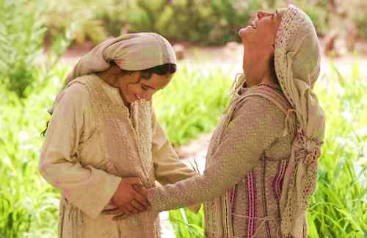
Fig. 1. Mary visits her cousin Elizabeth while both are pregnant.
They praise and thank God for the miracle of their babies.
“OK,” Sarah replies as she holds Isaac. She and Isaac give hugs and kisses to each of us and head home. We each bid her “Shalom.”
Joseph moves over to Mary to comfort her.
I turn to leave, “Joseph, I’ll take the donkey and go to the Inn’s kitchen to tell Mom what’s happening. Then I’ll go over to the wells to get water for us and to water your donkey. Shalom.”
The donkey and I walk up the hill to the doorway of the Inn’s kitchen where I tell Mom about Mary’s cry of pain and what she said. Mom replies, “Yes, Mary is correct. This is just the beginning birth pains during the birth of a baby. Here, take these two jugs for water you filled this morning at the well and give them to Joseph and Mary. What they do not drink, we will surely use when the baby arrives. Quickly, go now. I’m very busy. I will see you all later.”
I tie the necks of the water jugs together and pull them over the donkey’s back. We return to the stable cave to give two jugs filled with water to Joseph and Mary.
Then, I tie up eight empty jugs from the stable and put them over the donkey’s back and to lead it to the town’s water wells.
My Father said these wells are named for King David whom legend tells us actually dug these wells when he was a shepherd boy here.
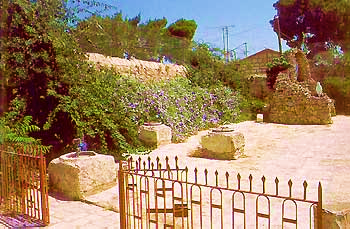
Fig. 2. King David's Wells - in Bethlehem today.
The donkey drinks the water from the well’s run-off. Meanwhile, I fill the water jugs and again load and tie them on the donkey’s back. No one is at the wells at mid-afternoon so my tasks go very quickly. Soon, we leave for the Inn’s courtyard stable.
Once there, I make sure all the animals have water and feed in their mangers. Also, they need enough slack in their tie ropes to give them room to lay down. Next, I sweep the areas and bring some fresh straw for the ground. As we leave, I tie the courtyard’s gate to secure it.
The donkey and I walk quickly down the hill toward our caves still with two jugs filled with water. Surprisingly, their donkey has been very cooperative, not stubborn as some can be. I like this donkey.
As I look closer, I see it has the features of a Syrian-bred donkey that is popular in Galilee. It’s a strong and docile donkey bred for setting a smooth gait which makes riding more comfortable. Hopefully, Mary’s long, hard journey to Bethlehem was made a little easier riding it.
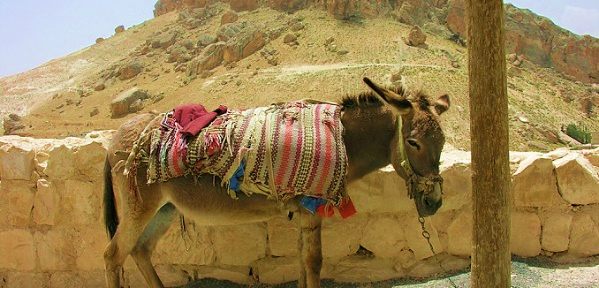
Fig. 3. Photo of Middle-East donkey.
By the time I arrive at the lower stable cave, Mom already returned to our home. Having finished cooking at the Inn, she’s gathering our few dishes and cups for dinner. She walks next door to set the dishes on the small work table Joseph places on the ground close to Mary. Yea! Soon we’ll eat! I hurriedly tie up the donkey to the stable fence and bring in the two extra jugs of water.
Mom tells us, “The innkeeper’s wife generously gave me extra food for Joseph and Mary as well as for us. We always treat Jewish visitors to our homes ‘as family’ and to love them and offer them food and rest.”
She announces proudly, “Tonight’s meal is a special treat. Since some of the Inn’s guests are influential people, the innkeeper decided to purchase a young sheep for this evening’s meal. He had our Rabbi supervise the butcher as he prepared the lamb according to the kosher rules.
The butcher roasted it all day in his own fire pit. Then the innkeeper had me add some of the roasted lamb meat to my vegetable stew for everyone at the Inn and for us.” We all happily bless the innkeeper and his wife.
For our meal, Mom infuses her special spices and simmers everything in the kettle that hangs over the fire pit outside our home. Mom also made fresh bread that is still warm and really smells good. Mom is a great cook!

Fig. 4. Pottery & wooden dishes used in Jesus’ time.
Our customs for a weekday meal are not as strict as for our Sabbath meal. So, we are starting our meal this late afternoon rather than at sundown. After the ritual of washing our hands, we recline around the table.
Our custom is to begin with prayers over a cup of wine. However, we can’t afford wine, so instead we can only serve water to our guests.
Joseph leads us in our Jewish prayers of blessings before our meal:
“Blessed are You, Lord our God, King of the Universe, Who brings forth bread from the earth, Who creates the fruit of the earth, and by Whose word all things came to be.” >
Mom serves the bread, vegetables, and meat stew. We pass it around the table and eat with great joy. Joseph is really hungry after their long trip and his repair work, so he eats heartily.
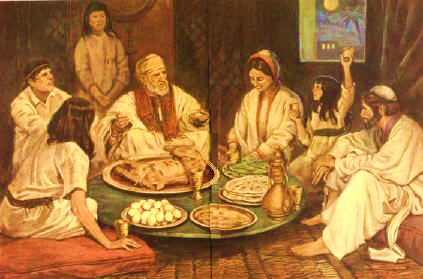
Fig. 5. Jewish family meal.
Mary only drinks water and some broth from the stew; she has no appetite right now. Mom encourages her to keep up her strength for the baby will be born tonight.
While Mom nurses Isaac, Sarah and I eat our tasty dinner with our youthful appetites. God provides plenty of food tonight.
We are excited to have these two visitors join our meal. We want to hear all about their adventures in travelling from the hillsides of Nazareth to the hills of Bethlehem in Judea. So I ask Joseph to tell us about their trip.
Joseph replies, “We travelled for 15 days including two Sabbath Days of Rest. It is about 100 miles by the route we took. We tried to travel eight to ten miles each day by foot with Mary sometimes riding on the donkey. We went slowly because of Mary’s pregnancy. And, we did not want to wear out our donkey who also carried our modest baggage—blankets, clothes, a few tools, and food. My cousin loaned me his donkey for this trip.”
“We left Nazareth on Wednesday morning and took the trade routes which were easier to travel along. We mainly used the trade route a few miles from the Jordan River so that we were close to water and shelter when needed. Eventually we had to buy food along the way for our journey.”
“We avoided the more direct route that crossed Samaria which is dryer and the people are known to be less hospitable to Jews heading toward Jerusalem.”
“Weather permitting, we usually started at dawn each day, paused mid-day, and ended when the sun set. We had to take some rest stops due to the steep hills, fatigue, rain, or the heat of the mid-day in the Jordan valley.”
“We were blessed by meeting kind merchant caravans who let us stay with them during the nights. They had guards protecting their encampments from roaming thieves and wild animals. During the day we sometimes met travelers who were very welcoming and encouraging, but our pace slowed them, so they would travel ahead of us after a while.”
“We camped right next to the Jordan River at sundown on Fridays and spent two Sabbaths with fellow Jewish travelers. We shared what little food we had among our small group and prayed and celebrated together. Getting a few days of rest during the long journey was a real blessing for Mary and me.”
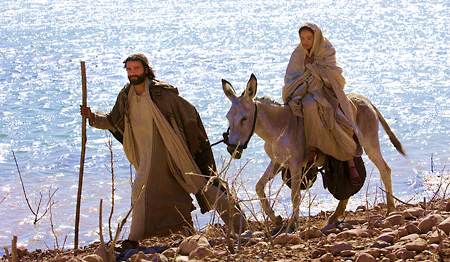
Fig. 6. Joseph and Mary travel to Bethlehem.
“Finally we reached Jericho and then slowly journeyed up the steep hills to reach Jerusalem, 3,400 feet up and a distance of 15 miles.
On our 13th day of travel, we made it to Jerusalem. We stayed with Mary’s elderly mother, Anne, in the same home of Mary’s birth. That day, Mary’s cousin Elizabeth and husband Zechariaharrived from their home just west of Jerusalem. They have a six-month old son, their first-born, so we were able to celebrate that joyful event with them too.”
“Mary had visited Elizabeth during her pregnancy. We call it their Visitation.”
“Zechariahis a Priest in the Temple. Someday we’ll tell you about the miracle of the birth of their son, John. It is quite extraordinary. The Spirit of God has been upon them.”
“Anyway, it was very restful and enjoyable to be with them again. I was even able to pray at the Temple that day. Zechariahoffered to officiate the circumcision of Mary’s first born eight days after his birth.”
“We left on Wednesday and travelled through Jerusalem towards Bethlehem. Along the way, we got caught in a heavy rain. Since we were just passing Rachel’s tomb when it occurred, we stopped to pray in a small shelter connected to the monument. The rain refreshed the dryness of the air and ground and resulted in the sweet smell of flowers.”
“Finally we arrived around noon at the Inn and met the innkeeper and your mother.”
“We are very grateful to God who gave Mary the strength for this trip. She is young and strong and will be a very good mother. We will thank God always for the wonderful people we met along the way as well. The trade routes are filled with all kinds of people from many countries.”
We are fascinated by Joseph’s description of their trip. What an adventure! I would love to travel.
Our Jewish custom at meals is to set apart some time to encourage children in their faith. Today, Joseph decides to translate for us the meanings of our names.
“Sarah, you have a name great in Jewish history. Sarah was the wife of Abraham; it means ‘princess.’ You are bright and beautiful as a princess.”
Sarah blushes, but she also smiles at hearing such wonderful compliments as she says “Thank you.”
As Joseph picks up and embraces Isaac he comments: “Isaac means ‘laughing.’ You are aptly named for you laugh a lot and cause us to laugh with you as well. In scripture Isaac was Sarah’s son whom God saved. He stopped Abraham from sacrificing Isaac to His Name. By that act God showed He does not want humans sacrificed.”
Isaac just giggles and laughs. Sarah and I nod to each other in amazement how good Joseph’s teaching is.
Next, Joseph puts his hand on my head: “Matthias, your name means ‘gift of God.’ You are very intelligent for your young age. Your help has been a gift of God to us as well as to the innkeeper, his guests and to the animals. You love all the animals God has created. They love you. We love you and God loves you.”
I am so overwhelmed by what he just told us I can barely speak. “Thank you. And I love you both,” is all I can say.
Surprisingly, he turns from us children over to Mom, “Rachel, as you know your name means ‘ewe, to be a good traveler.’ You have been another gift of God to us at the end of our travel to Bethlehem. You realize how difficult our journey has been, you know what our needs are, and you fulfill them. You are a special blessing to us and to your family.”
Mom is touched by Joseph’s sincere comments. She tears up a little bit, then smiles and gratefully says, “Thank you.”
She hesitates, “And may I ask you what names you have selected for your baby who will be born soon?”
Joseph looks to Mary who nods her approval—so he announces: “His name will be Jesus, meaning ‘Yahweh is salvation.’ He will be known as Immanuel, meaning ‘God is with us.’”
I want to ask him what their baby’s name would be if it is a girl. But I feel very uneasy to do that. I’m not sure why; perhaps it is because Joseph says the name “Jesus” with such confidence. However, Mom does not ask either. So, I think it best for me to skip my question for now.
We sing some psalms and are having such a good time that we forget how late it is – it’s twilight outside now, and Mary looks tired.
Joseph notices and ends the meal quickly with our prayer of thanksgiving. He adds a blessing for Mary and the delivery of her child.
“We are commanded by scripture that when we eat and are satisfied, we must bless the Lord our God.>
Blessed are You, Lord our God, King of the Universe, for providing this food, for our ancestors' Exodus from Egypt, for Jerusalem, for the goodness of Your work, and today especially for Mary and her baby.”
Afterwards, I step outside to look up the hill at the Inn’s windows. Some guests are shutting off their oil lamps to retire for the evening. It should be a cool and quiet night for all to sleep well. Even their animals sound quiet and peaceful
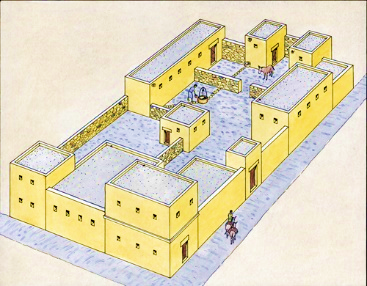
Fig. 7. A typical inn (in the Middle-East during Jesus’ time) with buildings arranged around a courtyard.
© Leen Ritmeyer.
Isaac already is asleep at Mom’s side.
My stomach feels full from the delicious meal and I am exhausted from a busy day.
Mom sees me yawn and says, “I brought our oil lamp here, so Sarah and I can take care of the dishes and clean up, Matthias. Why don’t you get some sleep? I will come home later. Do not forget to say your night prayers.”
“Yes Mother.”
I don’t need any more encouragement to leave. Tomorrow will be a busy day because the Inn’s guests will leave to return home after their registration for the Census. I will be needed to prepare all the animals for their journeys.
I hug and kiss everyone goodnight, wish them “Shalom” and leave.
On the way out I notice the 2 wooden mangers that Joseph repaired. They look like new and seem very sturdy. He even cleaned and washed the stone manger and moved the ox to the other side of the outside stable. All seems ready for the arrival of the baby.
As I look up I can see the first stars of the night above the western horizon. Hmm… I had noticed in the twilight of this morning that one of the moving stars—the planet the Romans call Jupiter—was hidden behind the moon. But the other star-planets seem to have moved closer together. They are still bright in the sky tonight. Strange, but beautiful.
I walk the short distance to our home next door and crawl under my blanket for a good sleep. I barely have the strength to say my night prayers which Father had taught me. I feel so good – and so very sleepy.
It feels as if the Spirit of God is upon Bethlehem—it is quiet, calm and peaceful.
---------------------------- End of Part 3
(Continue below to experience: Multi-Dimension LINKS)
MULTI - DIMENSIONAL LINKS
Click Gold highlighted internet LINKS to see and hear interesting Music Videos
Traditional, Modern, or New versions.
All these LINKS are to YouTube®©.
Modern About young King David by Chris Tomlin - Films and Music Inspired by "THE STORY"/ "Your Heart" (DAVID).
New"Song of Mary" by Dan Schutte. Beautiful Choir and trumpets
Traditional: "Ave Maria" sung by Sissel Kyrkjebø . A wonderful interpretation by a beautiful soprano with the voice of an Angel. (Schubert)
Mary’s prayer upon meeting her cousin Elizabeth is called the “Magnificat” as she praises God for her baby to-be-born.
Modern: “Magnificat (All That I Am)” by David Haas Wonderful music with lyrics shown in English and pictorial presentation of works of art.
Modern: “Magnificat (All That I Am)” by David Haas – guitar, with choir and instrumentals in background. Inspiring pictures related to his song.
New: Light Christmas Carol favorite for children – “Mary Rode upon a Donkey” by Richard Cootes. Mary, Joseph with donkey meet the innkeeper.
Popular Hebrew Song: Shalom Aleichem with English translation ("Peace be upon you") is a traditional song sung by religious Jews every Friday night upon returning home from synagogue prayer. Beautifully presented by Susana Allen & Hector David.
Classic Country: "Beautiful Star of Bethlehem" performed by The Judds .Beautiful voices, guitar and pictures on this video.
MULTI - DIMENSIONAL LINKS
Click Gold highlighted internet LINKS to experience 3-D Tours, Photos, Videos, Maps, Bible References, Food Recipes and additional interesting information.
Tour Mary’s Spring: When Mary visited Elizabeth she went to the village of Ein Kerem west of Jerusalem. According to tradition, Mary drank from this spring of water.
Tour Ein Karem: birthplace of John the Baptist, and The Visitation site. By BibleWalks.com.
Visitation of Mary and Elizabeth - Wikipedia: Mary was a cousin of Elizabeth, who was married to Zechariah. They visited while each was miraculously pregnant."
Elizabeth - Wikipedia: She was a cousin of Mary; wife of Zechariah and mother of John the Baptist.
Zechariah - Wikipedia: Husband of Elizabeth. He was a High Priest in the Temple of Jerusalem.
Note - Different spellings for same name due to translations: Zechariah, Zachariah, Zacharias, Zachary; and Elizabeth, Elisabeth.
Blessing Bread: by Jewish Online Guides Bread is the staple food of humankind; so, before eating it Jews make a special blessing of Hamotzi, thanking God for bringing forth bread from the ground. English intro, Hebrew prayer, video from YouTube.
List of Jewish Prayers and Blessings - Wikipedia: Blessings at meals included.
Kosher Foods - Wikipedia:. Foods allowed or disallowed to eat. Plus their preparations.
King James Version (KJV) audio recording of text of the Visitation of Mary with Elizabeth and the birth of John, son of Zechariah and Elizabeth.
New American Bible - Revised Edition with options for commentary and notes of the Visitation of Mary with Elizabeth and the birth of John, son of Zechariah and Elizabeth.
New International Version (NIV) text: Isaac is born of Abraham and Sarah. Everyone laughed that he would be born to such elderly parents, but God said it would be—and it happened.
Star of Bethlehem - Wikipedia: Several explanations are summarized as to what this star may have been.
Food & meals in the Bible. From "Women in the Bible" (Covers adult-level subjects.)
Figure # - Photo and Art Credits
Thankful and grateful for courtesy of:
Fig. 1. Mary visits her cousin Elizabeth while both are pregnant. They praise God for the miracle of their babies.
Immaculate Conception Catholic Church
seekingtheimmaculate.com
Fig. 2. King David's Wells - in Bethlehem today.
General Mission of Palestine - Tokyo
palst-jp.com
Fig. 3. Photo of Middle-east donkey.
Thriol
flickr.com/photos/thriol
Fig. 4. Pottery & wooden dishes used in Jesus’ time.
Elizabeth Fletcher
womeninthebible.net
Fig. 5. Jewish family meal.
John P. Pratt
johnpratt.com
Fig. 6. Joseph and Mary travel to Bethlehem.
Richard Blackaby
richardblackaby.com
Fig. 7. A typical inn (in the Middle-East in Jesus’ time) with buildings arranged around a courtyard.
© Leen Ritmeyer
www.ritmeyer.com.
Notice:
TThis eBook and story is for personal education, non-profit, and “fair use” only, and is not to be used for profit; this eBook is made available free of charge. This website contains no ads.
Do not publish or copy any of this material to Facebook, social media, or public file areas.
All copyrights are the property of the respective owners of: text, graphics, art works, maps, references, Bibles, articles, tours, and commentary, as well as of electronic information, images, photos, music, videos, dramatizations, audio readings, performances, and movies and all material at LINK sites included herein.
Although carefully based on the original Biblical accounts, the conversations and related events not explicit in the Bible versions are considered of the historical fiction genre of writings. References for Writing Genres and Historical Fiction -
https://en.wikipedia.org/wiki/List_of_writing_genres
https://en.wikipedia.org/wiki/Historical_fiction